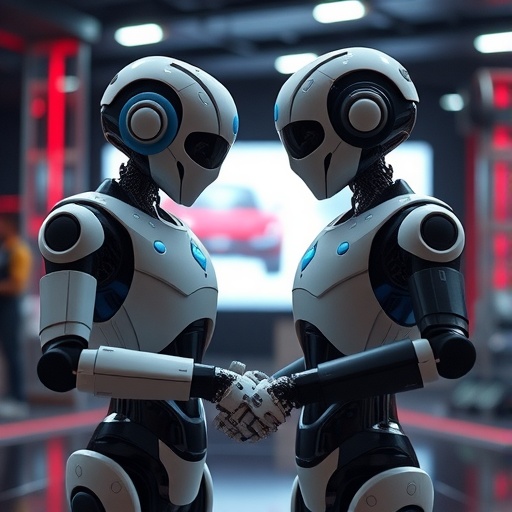In an era where automation and artificial intelligence are reshaping industries, the collaboration between humans and robots has become a focal point for researchers and engineers. One notable endeavor in this realm comes from the University of Colorado Boulder, where a team led by associate professor Morteza Lahijanian is on a quest to revolutionize human-robot interaction. Their groundbreaking study, which was recently highlighted at the International Joint Conference on Artificial Intelligence, aims to address the complexities of integrating intelligent machines into environments traditionally dominated by human workers.
At its core, this research tackles a critical question: how can robots safely and efficiently operate alongside humans in unstructured environments filled with uncertainties? Traditional frameworks for robotic operation often rely on predictable, structured settings. When humans enter the equation, unpredictability rears its head. Morteza Lahijanian and his team recognized that the mishaps and erratic behaviors of human operators could place both workers and robots at risk, potentially leading to catastrophic outcomes. By investigating how robots could make real-time decisions while maintaining safety, they offer a glimpse into a future where humans and machines can coexist harmoniously.
The foundation of this research lies in the adaptation of game theory—a mathematical domain that explores decision-making in competitive environments. In the context of robotics, the team proposes a model where the robot acts as a strategic player within a dynamic system that includes human operators, where each participant’s choices influence outcomes. This conceptualization of robots as active agents entangled in a complex game necessitates the development of algorithms that not only enable robots to complete tasks but also prioritize human safety.
The striking innovation here is the creation of algorithms that incorporate the notion of “regret” into the decision-making process of robots. Unlike traditional robotic programming, which focuses on guaranteeing success in task completion, these new algorithms allow robots to evaluate potential actions based on their future regret. In essence, if a robot can predict that an action might lead to regrets—say, by putting a human at risk or compromising a collaborative task—it will choose a safer path. This approach blurs the lines between machine efficiency and human-centric ethics, prioritizing collaborative safety above raw productivity.
As the research team explicates, robots will not merely be programmed to follow a rigid set of instructions; rather, they will immerse themselves in an analytical process that takes into account the unpredictable nature of human behavior. They model this by equipping robots with the capacity to simulate various scenarios, allowing them to foresee potential human errors and adapt accordingly. For example, in an automotive assembly line setting, if a robot detects a human operator becoming erratic, it will initiate a preemptive response—adjusting its position or slowing its pace—to prevent accidents, showing a deliberate shift from adversarial interaction to cooperative problem-solving.
The potential societal implications of this research are vast. As industries continue to adopt robotics and AI technologies, questions regarding their future roles emerge, including concerns about job displacement and the ethical implications of human-robot collaborations. However, what Lahijanian and his students propose offers a refreshing perspective: rather than replacing human jobs, robots could enhance human efficiency and alleviate burdensome tasks. In sectors like healthcare, where labor shortages loom, and in physically demanding roles that threaten worker health, collaboration with robots could pave the way for innovative solutions.
Lahijanian emphasizes the importance of flexibility in robotic design. A robot must operate under the assumption that it might encounter human workers of varying skill levels, from novices to seasoned experts. Therefore, it must adopt strategies that are adaptable to a spectrum of human capabilities. This adaptability underscores a fundamental goal of the research: to create robots that are not merely tools but partners capable of augmenting human decision-making and physical capabilities in meaningful ways.
As the study progresses, it challenges preconceived notions about man versus machine. The past fear of machines replacing human labor gives way to a more nuanced understanding—that when designed with safety and collaboration in mind, robots can complement human work, creating a synergistic environment that leverages distinct strengths. The vision articulated by Lahijanian culminates in an optimistic outlook on future workplaces, where human judgment and robot precision blend seamlessly, ultimately benefiting society at large.
In practical terms, the algorithms developed by this research team present a revolutionary method of programming robots, enabling them to appraise real-time situations in ways that were previously thought unattainable. The dynamic interplay between robots and humans shifts from a transactional relationship to a collaborative partnership characterized by mutual respect and safety. As industries witness a paradigm shift toward this new form of collaboration, the potential for enhanced productivity and safety is immense.
Ultimately, as Morteza Lahijanian puts it, human-robot collaboration is about combining complementary strengths. Humans contribute judgment, contextual awareness, and creativity, while robots provide speed, precision, and reliability. This synergistic relationship stands to redefine the possibilities for productivity across various sectors, reshaping the landscape of work for future generations. In this cooperative future, the lines blur not just between human and machine, but between work and life, as the promise of automation expands to enrich the human experience.
As this research continues to unfold, it challenges us to reimagine our relationship with technology. Rather than viewing robots as competitors, we are invited to understand them as allies—partners in a shared mission to enhance human potential while mitigating risks. The implications for industries, economies, and societal structures are profound, leading us to a future where coexistence with sophisticated machines doesn’t just coexist with humanity, but flourishes within it.
Subject of Research: The integration of robots in human environments focusing on safety and collaboration
Article Title: Advancements in Human-Robot Interaction: The Future of Collaborative Workspaces
News Publication Date: October 2023
Web References: University of Colorado Boulder
References: Game Theory Applications in Robotics
Image Credits: Casey Cass/University of Colorado Boulder
Keywords
Robotics, Artificial Intelligence, Human-Robot Interaction, Manufacturing Automation, Game Theory.




